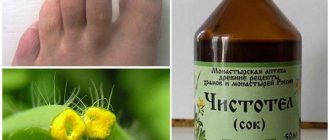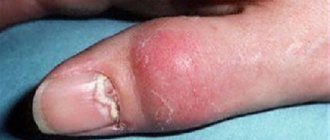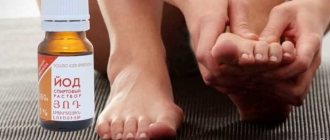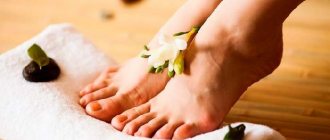Currently, the fungus is found in 20% of the total population. According to epidemiological studies, there is an increase in incidence. Moreover, the average estimated duration of the disease (in the presence of dozens of effective antimycotics) is 20 years, and according to the results of a survey of middle-aged patients, it is about 10 years. This fact indicates the great importance of preventing fungal pathologies.
The occurrence of mycoses is provoked by mold fungi - dermatophytes belonging to three genera - Epidermophyton, Microsporum and Trichophyton. In total, 43 species of such fungi are known, 30 of which are causative agents of the disease.
You may also be interested in:
144 rubles Clotrimazole lotion for nails and skin ®, 15 ml
140 rubles Mikospray ® cosmetic hygienic spray with antibacterial effect, 100 ml
155 rubles Foot cream for calluses and cracked heels ®, 75 g
Indications for use: dermatophytosis of the feet (“athlete’s foot”), nail fungus (onychomycosis)
The term “athlete’s foot,” which is increasingly appearing in the Russian language, even in specialized literature, is borrowed from English. The reason for this unusual name is simple: gyms and swimming pools are the most common places where you can become infected with fungus. But, alas, the list is not limited to this. Statistics show that a large number of people with this diagnosis are not athletes at all, but quite ordinary visitors to baths and saunas. However, that’s not all – you can become infected with mycosis while visiting friends by wearing the offered slippers; or trying on shoes in a store. Moreover, the fungus can remain on the skin of the feet for years without developing, thanks to the work of the body's immune system. However, a slight failure of the immune system is quite enough for symptoms to appear. Also, the development of the disease is provoked by wearing tight or damp shoes, or, often forced, non-compliance with hygiene procedures.
Manifestations of mycosis
Many people with athlete's foot are not even aware of the presence of the pathology, since the primary symptom is dry skin, a slight burning sensation and itching. Often this is attributed to the characteristics of the skin, and no one goes to the doctor.
As the disease progresses, peeling begins, and in severe cases, cracks appear that can hurt and bleed. Another important sign is the presence of scales and wounds between the fourth and fifth fingers.
To summarize, we can say that this disease is characterized by:
- Itching and peeling in the 3rd, 4th, sometimes in the 1st interdigital fold.
- The appearance of skin cracks.
- The spread of the lesion to the entire foot, the formation of the so-called. moccasin type.
- Increased unpleasant foot odor, especially when a secondary bacterial infection occurs.
- The appearance of small bubbles and “wetting” blisters.
It is also important to note that the fungus can spread from the feet to other parts of the body: most often the nails (onychomycosis) and the groin area are affected.
Release form
You can buy the product at any pharmacy; it is a cheap local antimycotic. The price of the drug may vary depending on the form of release. The medicine can be in the form of:
- cream;
- gel;
- ointments;
- solution;
- capsules
The solution is most often used to treat fungal infections on the nails: the liquid penetrates the nail plate much more easily. Clotrimazole creams and ointments also have a good effect: foot fungus disappears after a course of use.
These are the most popular forms of release; they have similar compositions and instructions. However, the ointment is quite greasy, so it takes a long time to absorb, which is not very convenient, and leaves marks and stains that are difficult to remove.
Clotrimazole cream is more convenient, it has a soft structure and is absorbed almost instantly. Therefore, this option is more suitable for people with a lack of time. Those with overly sensitive skin should be more careful when handling this product, since it is the cream that often causes an allergic reaction, but the ointment, on the contrary, improves the condition of the epidermis: it nourishes, moisturizes and gives elasticity.
Prevention and treatment of fungal diseases of the skin and nails.
Mycosis is one of those diseases for which daily prevention is vital, especially if the patient is part of a “risk group” - regularly visits baths, a gym or a swimming pool; or daily activities do not allow regularly changing socks and shoes. Moreover, even without getting sick with the fungus, a person can bring a kind of “gift” home. The causative agent of the disease is extremely tenacious and can infect family members by moving through bed linen, towels, bathroom rugs, etc.
As mentioned above, the course of treatment for mycosis can last for many years and require the regular use of expensive ointments, and in many cases, systemic medications, which have a complex and not always beneficial effect on the entire body. So, what measures need to be taken to prevent fungus from becoming a household item?
- It is necessary to keep your feet clean and dry and change your underwear regularly.
- You need to choose shoes from “breathable” materials.
- Do not walk barefoot in a bathhouse, swimming pool or fitness club locker room.
- Be sure to use socks where you need to take off or change shoes: for example, when using replacement shoes in a bowling alley; during inspection at the control line at the airport; at a party, when you have to use “guest” shoes, etc.
- When visiting pedicure salons, it is advisable to use your own tools, including nail files. This is especially important if you are not sure that the salon practices strict sterilization of instruments.
- Regularly carry out disinfection procedures for shoes and foot skin using special antifungal agents containing the active antifungal agent - clotrimazole.
Carrying out disinfection procedures is especially important if infection has already occurred. In this case, it is necessary to avoid cross-infection and prevent the fungus from spreading to all family members. To do this, it is necessary, firstly, to use strictly individual household items and, secondly, to treat absolutely all shoes in the house with a preventive composition containing clotrimazole.
Pharmacological properties
Many patients, having tried numerous medications, doubt whether Clotrimazole helps with nail fungus. To find out the answer, it is worth considering the substances that make up this drug and finding out its properties . Antifungal ointment contains:
- glycerol;
- propylene glycol;
- sage essential oil;
- carbomer.
In addition to these elements, the composition includes Clotrimazole, which is why the product got its name. Clotrimazole for foot fungus is one of the most effective fungicidal drugs; it has a complex effect:
- dries the wound;
- destroys pathogens;
- promotes regeneration of affected nails and skin;
- prevents the addition of a secondary infection;
- cauterizes the affected surface of the epithelium.
In addition, the product prevents the production of ergosterol, which means that fungal spores stop spreading. Due to the impaired integrity of the micromycete membrane, fluid is lost, and this, in turn, leads to the destruction of mycosis at the cellular level.
Effect of clotrimazole
Clotrimazole is a topical substance, practically not absorbed through the skin and mucous membranes and does not have a systemic effect, which makes it safe for daily use.
The antifungal effect of clotrimazole is associated with a disruption in the synthesis of ergosterol, a substance involved in the construction of the intracellular membrane of the fungus, which causes subsequent dissolution (lysis) of the cell.
The drug is effective against a number of dermatophytes (Trichophyton rubrum, Trichophyton mentagrophytes, Epidermophyton floccosum, Microsporum canis). In addition to the antifungal, clotrimazole has an antimicrobial effect against gram-positive (Staphylococcus, Streptococcus) and gram-negative bacteria (Bacteroides, Gardnerella vaginalis).
Directions for use and dosage:
The drug is used externally!
The lotion is applied in a thin layer to previously cleansed and dried skin 2 times a day, morning and evening, and rubbed in gently.
It is recommended to pre-clean the skin with pH-neutral soap.
The duration of the course depends on the severity of the disease. In general cases, treatment of dermatomycosis is carried out for at least 4 weeks. After eliminating the main symptoms of the disease, therapy should be continued for another 2 weeks.
Patient reviews
My daughter is a swimmer, so we know about mycosis firsthand: it is, so to speak, an occupational disease in our country. Previously, it was very difficult; we spent a lot of money on various antifungal agents, but they didn’t help much. Now we always have Clotrimazole with us, and this is the second year without a single infection. We use it for prevention; we treat our feet once a week.
Oksana
I am a student, I got a room in a dorm, naturally, a shared shower. There I became infected with a fungus, and this is not the first time this problem has happened to me. This time, a friend advised me to buy Clotrimazole, and, to my surprise, the infection went away in just over a month. I was able to get rid of my previous defeat only after six months. I was treated as follows: I treat the entire foot between the toes, I do it in the morning, afternoon and evening. So I advise everyone, the cream really helps a lot.
Victoria
I am 57 years old, four months ago I noticed a fungus on my big toe nail.
I went to the clinic to see a dermatologist, he prescribed me Clotrimazole. I treated my leg every day, everything exactly according to the instructions, after 2.5 months the fungus disappeared. The product is very good and inexpensive, which is especially nice for pensioners. Gregory
Contraindications and precautions:
- Individual intolerance to clotrimazole or other components of the lotion.
- First trimester of pregnancy.
- The use of the drug during the second and third trimester of pregnancy is allowed only after consulting a doctor.
- Use with caution during lactation. Applying lotion directly to the mammary gland while breastfeeding is not recommended.
- Do not use internally!
- Keep out of reach of children.
- If the drug gets into the gastrointestinal tract, consult a doctor immediately.
About overdose and interactions with other drugs
Getting an overdose of a medicine for external use in any pharmaceutical form, be it cream or ointment, is quite problematic. When taking a large number of tablets, you may experience nausea or even vomiting, stomach pain, and slight dizziness. If this happens, doctors advise immediately stopping taking the medication, rinsing it and, if necessary, visiting a doctor. In certain situations, if a gel or solution is used, you may notice the formation of itching and redness.
Doctors also advise quickly washing off any remaining drug and drying the area of the skin. Future use of the medication is not recommended. In such a situation, you need to visit a specialist to identify the formation of the problem, conduct tests for the allergic reaction of the body and choose an analog medicine.
The use of Clotrimazole together with other drugs can inhibit the effectiveness of the drug and reduce the quality of the fight against fungal infections on the legs.
Any cutaneous infectious disease that is caused by yeast, mold, fungal parasites (the most common) and dermatophytes (slightly less common) can be eliminated with the help of Clotrimazole. If there is an abscess infection, mycosis of the skin or legs, then doctors recommend using the ointment. When the nail base becomes infected, it is recommended to use the Clotrimazole solution, as it quickly and perfectly saturates the nail structure. Every person should definitely take care of their nails: if they have many small spots, stripes, or a strong odor, then these are symptoms of a fungal disease.
At the next stage of development of the infection, the nail plate becomes dark brown and begins to rot, even worse when the infection tries to spread to other areas of the skin. Effective Clotrimazole ointment should be used when there is the first sign of a fungal disease and to prevent it when going to a pool, water park or public places with water.
If the patient has received at least one contraindication to clotrimazole, then there is no need to use this medicine in any form. During the period of feeding an infant, the medicine can be applied exclusively to the toenails, while constantly checking that it does not get into the mammary glands. In another situation, Clotrimazole ointment will quickly get into the milk and harm the baby.










